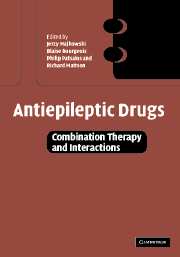Book contents
- Frontmatter
- Contents
- List of contributors
- Foreword
- Foreword
- Acknowledgements
- Part I Introduction
- Part II Pharmacokinetic interactions
- Part III Pharmacodynamic interactions
- Part IV Drug interactions in specific patient populations and special conditions
- Part V Conclusions and future perspectives
- 23 Selection of drug combinations in clinical practice: current and future perspectives
- 24 Future research: an experimental perspective
- 25 Future research: a clinical prospective
- Index
25 - Future research: a clinical prospective
from Part V - Conclusions and future perspectives
Published online by Cambridge University Press: 07 September 2009
- Frontmatter
- Contents
- List of contributors
- Foreword
- Foreword
- Acknowledgements
- Part I Introduction
- Part II Pharmacokinetic interactions
- Part III Pharmacodynamic interactions
- Part IV Drug interactions in specific patient populations and special conditions
- Part V Conclusions and future perspectives
- 23 Selection of drug combinations in clinical practice: current and future perspectives
- 24 Future research: an experimental perspective
- 25 Future research: a clinical prospective
- Index
Summary
Introduction
Although the best standard guideline for the treatment of epilepsy is to treat patients with monotherapy antiepileptic drugs (AEDs) first, the use of AEDs in combination to treat patients with intractable epilepsy is a long-standing clinical practice. The concept of monotherapy is relatively new, having its origin in the mid-1970s (Leppik, 2000). Monotherapy implies the use of a single active entity and its advantages are recognized. These include avoidance of drug–drug interactions, enhancement of compliance and the reduction of adverse effects. But is this true? What is the benefit/risk ratio of polypharmacy compared with monotherapy? Are all the combinations of AEDs useful and/or equally useful? What doses of AEDs in polypharmacy and in monotherapy must be compared?
With our enhanced understanding of the mechanisms of ictal events and mechanisms of action of the traditional and new (second generation) AEDs, as well as the licensing of new AEDs having a variety of mechanisms for antiepileptic action, the concept of ‘rational polypharmacy’ (RP) has been developed (Homan, 1997). Although it may appear as a paradox, the goals of RP are to minimize total AEDs used, to personalize antiepileptic treatment, to develop more specific targets for therapy and to maximize the therapeutic index. Therefore, the heart of RP is the use of two (and only occasionally more than two) agents to give better seizure control with the lowest dose of each AED and with minimal adverse effects.
Keywords
- Type
- Chapter
- Information
- Antiepileptic DrugsCombination Therapy and Interactions, pp. 458 - 474Publisher: Cambridge University PressPrint publication year: 2005



